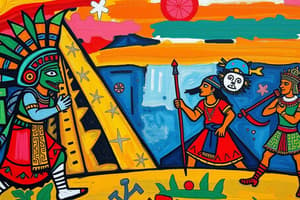Podcast
Questions and Answers
¿Cuáles eran las deidades prominentes en la religión azteca?
¿Cuáles eran las deidades prominentes en la religión azteca?
Huitzilopochtli, Tonatiuh, Tlaloc, Quetzalcóatl
¿Qué papel jugaba el sacrificio humano en las ceremonias religiosas de los aztecas?
¿Qué papel jugaba el sacrificio humano en las ceremonias religiosas de los aztecas?
Jugaba un papel importante, especialmente en rituales de guerra y fertilidad.
¿Quién fue el noveno emperador azteca que fue tomado prisionero por Hernán Cortés?
¿Quién fue el noveno emperador azteca que fue tomado prisionero por Hernán Cortés?
Montezuma II
¿Qué factores contribuyeron a la caída del Imperio Azteca ante la invasión española?
¿Qué factores contribuyeron a la caída del Imperio Azteca ante la invasión española?
¿Qué características definieron a la sociedad azteca en términos de organización política?
¿Qué características definieron a la sociedad azteca en términos de organización política?
¿Cuál fue el evento que marcó el fin del Imperio Azteca en 1521?
¿Cuál fue el evento que marcó el fin del Imperio Azteca en 1521?
¿Qué evento marcó el comienzo de la caída del Imperio Azteca en 1519?
¿Qué evento marcó el comienzo de la caída del Imperio Azteca en 1519?
¿Qué elemento clave utilizaban los aztecas en su sistema agrícola altamente productivo?
¿Qué elemento clave utilizaban los aztecas en su sistema agrícola altamente productivo?
¿Quién lideró a los Mexicas en la fundación del Imperio Azteca?
¿Quién lideró a los Mexicas en la fundación del Imperio Azteca?
¿Qué tipo de estructuras permitieron a los aztecas producir múltiples cosechas al año en su sistema agrícola?
¿Qué tipo de estructuras permitieron a los aztecas producir múltiples cosechas al año en su sistema agrícola?
¿Cómo se conoce también al Imperio Azteca?
¿Cómo se conoce también al Imperio Azteca?
¿En qué siglo alcanzó su apogeo el Imperio Azteca?
¿En qué siglo alcanzó su apogeo el Imperio Azteca?
Flashcards are hidden until you start studying
Study Notes
Aztec Empire
Introduction
The Aztec Empire, also known as the Mexican Empire, was a powerful and influential pre-Columbian civilization that flourished in Mexico from the 14th to the 16th centuries. It reached its peak during the 15th century and was renowned for its advanced art, architecture, agriculture, and societal structure. The fall of the Aztec Empire began in 1519 when Spanish explorer Hernán Cortés arrived in Mexico and set off a chain of events leading to the eventual collapse of the Aztec civilization.
Aztec Agriculture
Central to the Aztec civilization was the development of a highly productive agricultural system. The key element of this system was the use of chinampas, or floating gardens, which allowed for intensive cultivation on marshy lands around Lake Texcoco. These raised fields were constructed by stacking layers of plant material and clay, creating fertile soil for crops such as corn, beans, squash, and tomatoes. Chinampas enabled the Aztecs to produce multiple harvests per year, contributing significantly to the growth and prosperity of the empire.
Aztec History and Expansion
The Aztec Empire was founded by the Mexica people, who were led by their god Huitzilopochtli. They established Tenochtitlan as their capital city on Lake Texcoco around 1325 AD. Over time, the Aztecs formed alliances with neighboring states and gradually expanded their territory to include about 5 million people spread over 80,000 square miles by 1519. Their society was characterized by an egalitarian division into calpulli, or large extended families, but also exhibited signs of social stratification due to the existence of an hereditary nobility. The empire was organized into provinces, with governors, tax collectors, courts of justice, military garrisons, mail services, and other civil offices.
Religion
The Aztecs had a complex religion that absorbed elements from various Mesoamerican cultures. Prominent deities included Huitzilopochtli, Tonatiuh, Tlaloc, and Quetzalcóatl, among others. Human sacrifice played a role in religious ceremonies, particularly for war and fertility rituals.
Hernán Cortés and the Spanish Conquest
In 1519, Hernán Cortés arrived in Mexico with a small force of European soldiers. Initially, he gained access to Montezuma II, the ninth emperor of the Aztecs, who believed Cortés to be a returning god. However, Cortés soon took Montezuma prisoner, and he died in Spanish custody in 1520. After this event, his successors, Cuitláhuac and Cuauhtémoc, were unable to resist Cortés' forces. The Spanish ultimately took control of Tenochtitlan in August 1521, marking the end of the Aztec Empire.
Conclusion
The Aztecs created an advanced civilization marked by impressive architecture, agriculture, religious practices, and sociopolitical organization. Their society was characterized by both egalitarianism and social stratification, with a complex system of governance that allowed for local autonomy within a centralized empire. Despite their great achievements, they fell to the Spanish invasion led by Hernán Cortés, who exploited factors such as resistance to Montezuma II's rule, the use of superior technology, and the spread of European diseases among the indigenous population.
Studying That Suits You
Use AI to generate personalized quizzes and flashcards to suit your learning preferences.




